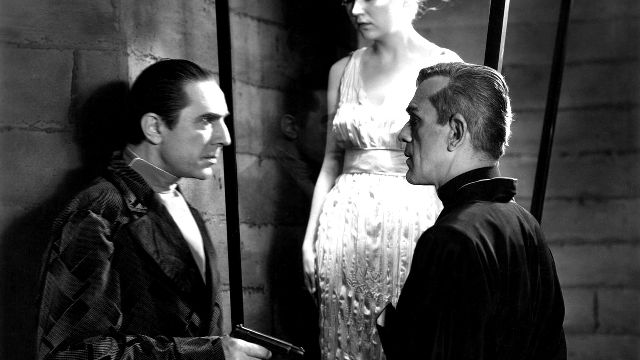The Black Cat (1934) 
“Things you never saw before or ever dreamed of!”

Director: Edgar G. Ulmer
Cast: Boris Karloff, Bela Lugosi, David Manners
Synopsis: American honeymooners in Hungary are trapped in the home of a Satan- worshiping priest when the bride is taken there for medical help following a road accident.
When a studio has vintage horror icons Boris Karloff (The Bells, The Secret Life of Walter Mitty) and Bela Lugosi (Murders in the Rue Morgue, White Zombie) going head-to-head for the first time, you’d think that it wouldn’t be necessary for them to resort to the cheap trick of credibility-by-association, but that’s what Universal does with The Black Cat. The opening credits proclaim that the film is “suggested by the immortal Edgar Allan Poe classic,” which is just completely wrong in every way imaginable. Poe’s tale was of a murderer who walled up his wife’s body without noticing that he had also trapped the eponymous cat, whose subsequent cries prove to be the killer’s undoing, while the movie’s is a rather confused one of Satanism and revenge. On a couple of occasions we do see that Lugosi’s character suffers from an abnormal fear of cats when Karloff’s black moggy wanders into shot for no reason, but his phobia has absolutely no reason for existing other than as some lame attempt at justification for that “suggested by” stunt.
The Black Cat sees newlyweds Peter (David Manners — The Death Kiss) and Joan Alison (Julie Bishop, credited as Jacqueline Wells) having to share their cabin on the Orient Express with Dr Vitus Werdegast (Lugosi), a vaguely unsettling character who is strongly reminded of his own wife by Joan. The bus the three share to the hotel after their train journey overturns in a storm, killing the driver and slightly injuring Joan, so they take refuge in a nearby house. The strange, modernistic building is home to Hjalmar Poelzig (Karloff), Werdegast’s former commanding officer in the Great War who sold out to the enemy in order to save his own skin, leaving his men at their mercy. As a result of Poelzig’s treachery, Werdegast spent fifteen years in prison and, to add insult to injury, while he was incarcerated, Poelzig married his wife. Then, to add a bloody-great-knife-in-the-back to insult, when Werdegast’s ex-wife dies he marries her daughter! So you could say there’s a little bit of history there, and could be forgiven for thinking Werdegast has a score or two to settle.
Poelzig is as taken by Joan Alison as Werdegast was, only his admiration of her is not quite as benign, and he has no intention of letting her leave his fortress-like home. If that wasn’t bad enough, he’s also some kind of Satan worshipper…
The Black Cat’s storyline really is as daft as it reads, but the movie is better than it ought to be for two reasons. Firstly, it gives us the opportunity to see two greats of vintage horror locking horns at a time when they were both major stars. They’re both creaky and over-theatrical, and couldn’t for one moment be described as actors of any particularly high quality, but their mere presence brings an atmosphere to the movie that it would otherwise be lacking if their parts had been taken by any other actors. They certainly outshine all other members of the cast — particularly the rather colourless David Manners, whose job is made all the more difficult by having to play a so-called hero who does nothing other than to shoot in the back a man who’s trying to help his wife.
Secondly — and more importantly — The Black Cat is directed by Edgar G. Ulmer, one of Hollywood’s most under-appreciated directors. Ulmer spent the major part of his career toiling away at the Poverty Row studio PRC, firstly through necessity when mainstream studio’s blacklisted him for having an affair with Shirley Castle, the wife of Max Alexander, who was the nephew of Universal’s President Carl Laemmle, and then through choice for the creative freedom his position at PRC gave him. There’s a scene late in The Black Cat in which Karloff recites Latin mumbo-jumbo during a Satanic gathering. It’s typical B-movie hokum, and would be laughable if it wasn’t for the way Ulmer keeps cutting away to shots of his fellow Satanists as they look on. The shots are brief but hugely atmospheric and lend a gravity to the scene that at least neutralises its otherwise banal subject matter. It’s rare that you find such a contrast between fine direction and hack writing in a film, but when you do come across it there’s a fair chance that it’s a movie directed by Ulmer. The shot in which we see the Alisons’ framed within the frame by Poelzig’s arm grasping the arm of a table figurine ever-tighter as he watches the couple kiss tells us far more than a study of Karloff’s expression ever could, and you can bet your life that little touch wasn’t in Peter Ruric’s screenplay. And the scene in which Poelzig visits his dead wife is both haunting and chilling in equal measure.
The Black Cat isn’t a great movie, but its inestimably superior to most other horror B-movies made in the mid-1930s, and is unusual both for the attention it lavishes on set design — Poelzig’s house is unexpectedly and deliciously modernistic — and an increasingly dark tone that culminates in an off-screen flaying that will stay with most viewers for a long, long time.
(Reviewed 28th August 2014)
httpv://www.youtube.com/watch?v=fuX3YFmqmSw
